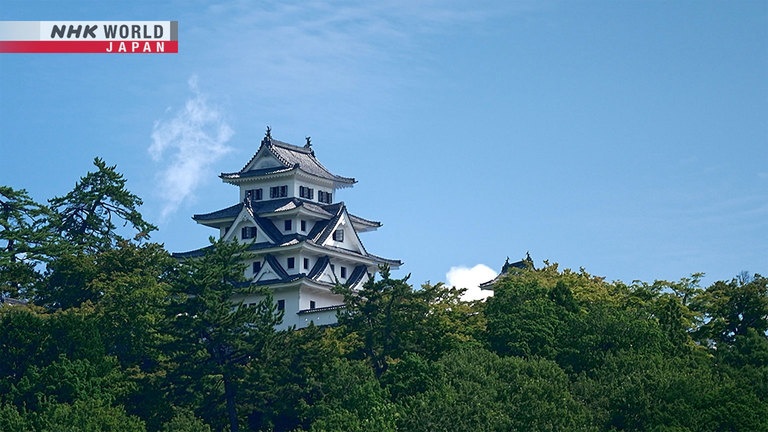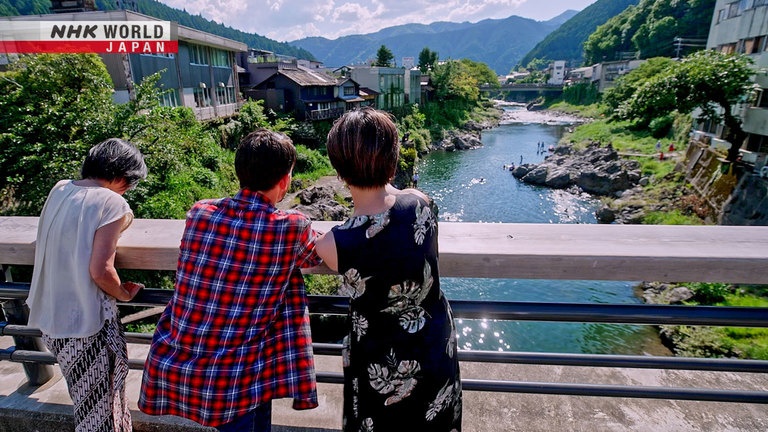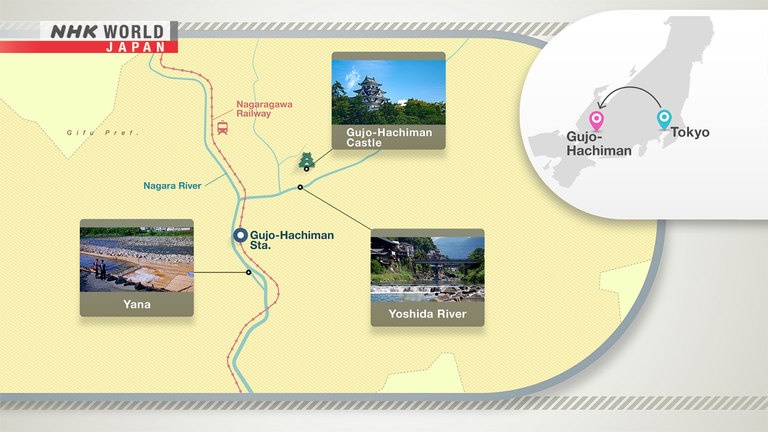Gujo-Hachiman: Dancing the Night Away
The Gujo Odori, one of Japan's largest Bon dances, is a spectacle with the scores of revelers, as well as the live festival music and clacking geta wooden clogs. For more than 400 years, it has been held for 30 nights from July to September in Gujo-Hachiman, a village located deep in the mountains of Gifu Prefecture. The main event is the all-night dance for four days starting on August 13. French actor Robin Barde explores the deep culture of the festival and dances the night away.
Gujo-Hachiman Castle

The beautifully reconstructed wooden fortress, also known as the Castle in the Sky, dates back to the mid-16th century.
Yoshida River

The crystal-clear river runs through the center of town. In summer, it's a playground for kids.
Yana

Gujo-Hachiman is famous for its ayu sweetfish, some of the tastiest in Japan. The traditional fishing method here, dating to the Edo period (1603-1868), is named yana after the bamboo platform that traps the fish during spawning season, from the end of September through October.
Access

It's about three and a half hours from Tokyo to Gujo-Hachiman by Shinkansen to Nagoya with a transfer to local trains.
Transcript
"Journeys in Japan"
Summoning the spirits home every summer since time immemorial...
in a dance called the "bon odori."
In one place, it's done like no other.
The revelers, spellbound, dance for over 30 nights.
Gujo Hachiman.
Nestled deep in the mountains, it's famous as a castle town
with pristine spring waters.
French actor Robin Barde
joins in the celebration of the past and the present,
dancing the night away on "Journeys in Japan."
Gujo Hachiman: Dancing The Night Away
Gujo Hachiman is in central Gifu,
250 kilometers west of Tokyo.
Well, I've made it. Gujo Hachiman,
a quiet town hidden in the heart of the mountains.
And what a lot of people will come here to see in the heat of the summer
is Gujo Odori, a dance,
performed in every corner of the city almost every night for over 30 nights.
I cannot wait to see it and take part in it,
but we still have some time left before the sun sets, so
let's have a look around Gujo Hachiman before the dance starts.
A vibrant city grew up around the Gujo Hachiman Castle,
which dates to the mid-16th century.
A short while after this castle was built,
the local lord wanted to strengthen the sense of community amongst his population,
so he encouraged all the different dances from each neighborhood
to get together in a big gathering for "obon" festival.
And this is said to be what gave birth to what we know now today
as Gujo Odori, Gujo's Dance.
In all its many years, nothing has stood in its way,
not even war.
I'm really impressed by how well they managed
to keep the atmosphere of the epoch alive.
It's actually quite impressive when you think about it.
Very charming. I love it.
Are you Takada san?
Takada Yuka is an authority on Gujo Hachiman.
Those little extensions on both sides of the house are called sleeve walls.
What do you think they're for?
They have been here since the 18th century.
What is the most concerning aspect of wooden structures?
I get it. Fires. The same throughout the world.
That's right. The design keeps fires from spreading.
For fire protection.
There are other fire prevention designs,
like canals on both sides of the road,
and buckets under eaves.
This is slotted in to raise water levels.
So it's easier to wash things like harvested vegetables.
And to cool down the street.
It was devised in the 18th century when there was no convenient water supply.
Wow.
- Amazing, right?
- Yes. Incredible.
It's a rite of passage for the kids here.
This is my daughter, Sayaka.
- Did you jump too?
- Of course.
You see the triangular rock there? You start from that point.
Then you jump from the higher point to test your nerves.
That's like about 5 meters?
Yes. Very scary. But the final goal is much higher.
The highest point?
Yes. That bridge you see over there. It's about 15 meters high.
The river is deeper there?
Yes. Much deeper.
We never do it alone. We are always with friends to do it safely.
So, you jump responsibly.
Oh, I wonder what that is? It's like some sort of bridge or...
I've never seen that.
There's somebody over there. I'm going to ask what he's doing.
Excuse me. What is this?
He's going to explain to us.
I have never seen this before. What is this?
This is a trap for catching "ayu" fish.
This local fishing method called "yana"
uses a bamboo platform to catch ayu sweetfish
during the spawning season from late September through October.
(Late September, 2022)
This area has long been renowned for the delicacy.
This early 18th century painting shows that the yana was already in use
in the same location as today.
The ayu here get their distinctive mellow flavor
from feeding on the algae that grows abundantly in this fast-flowing river.
For one of the first times in my life,
I'm getting like a whole fish from the head to the tail.
And this was like super easy to eat, and super, like,
vivid nature in your mouth. Like, yeah, really good.
Wait. I think I can hear some music over there.
Maybe the dance is about to start. Let's check it out.
At the heart of the 30 nights of dancing has always been inclusivity,
as people were encouraged to join in no matter their status.
This tradition endures.
First contact with Gujo Odori.
This is absolutely breathtaking.
I'm amazed by the number of people, and the fact that
everybody is dancing.
And I cannot imagine how we're going to get from here to one step further
because the main event is coming, "urabone," obon's festival.
People are going to dance for four nights in a row,
all night long, from dusk till dawn.
So I have to get as prepared as I can before I join in.
The origin of the Gujo dance is in mountain worship.
When the ancestral gods descend from the mountain, evil spirits tag along.
They bring disease, infection, and other bad things.
To drive out those evil spirits, we make noise.
"Geta" have been used for this from ancient times.
So by constantly stomping harder and louder, the space gets more and more purified.
This is the origin of the Gujo Odori.
Given that dancers wear out many pairs during the 30 nights of dancing,
geta shops are still common in this town.
- Hello.
- Hello.
What makes your geta for dancing different?
Dancing geta are made of local cypress to be light, strong and acoustic.
Their sound brings the revelers together as one.
To withstand the dynamic dancing, the teeth are not cobbled in.
Rather the entire geta is carved out of a single piece of wood.
Morohashi Yuto is not from Gujo.
About a decade ago, while studying woodworking,
a friend introduced him to the Gujo dance. He was hooked.
He was shocked to learn that local wood
was no longer being used for the festival geta.
Yet, forest covers some 90 percent of Gujo.
So Yuto was inspired to relocate,
craft geta from the many trees,
and open a shop specializing in geta just for dancing.
Weren't you worried about whether the locals would accept you?
Yes. I was a bit.
But everyone said they saw me as a partner to promote the festival.
And that was the deciding factor in starting my shop.
Here you choose the size and the snare cord. And I customize the geta right away.
These are Gujo indigo-dyed.
Simple and impressive. I'll take them.
I'll make some adjustments.
They're surprisingly easy to walk in and lightweight.
What are your goals for the future?
I want to continue to make geta locally.
He's recently started geta-making workshops at local schools.
After all, I can make them because of the Gujo festival.
So I want to find ways to give back to the city.
Good luck with your dancing.
Thank you.
Please select a design you like.
- Anything?
- Yes.
Since you're in Gujo, I recommend a typical local design.
There are three important items for the Gujo dance. The "tenugui," geta, and "yukata."
We will make the tenugui here today.
Most customers choose 2 or 3 designs.
Press like this.
- Looks good.
- Well done.
I think I did OK. I feel a sense of accomplishment.
You did good.
How long have you been running this shop?
I am now in my eleventh year.
I am not from here. My husband is from Gujo.
I could have not done it without the locals' support from the beginning.
I owe it all to them.
People here must be open-minded.
You're right.
That's how I could keep on going.
It's done.
I now have my own tenugui.
I even got my name in Japanese on it.
That's super cool! Yeah, I like it.
It's been four years due to the pandemic. How do you feel?
We couldn't even practice. So now I can't contain my excitement.
I couldn't get over the fact there was no summer dance.
I've been dancing since before I got married.
I can't even remember how I passed the last 4 years.
And now it's back finally! I'm so looking forward to it!
You haven't quite got it. We're almost there.
That one suits you better.
The festival highlight commences.
All-night, uninterrupted dancing spanning four days.
Wow. Okay, so the place is rocking.
That's amazing. The idea is to find a way in there
and try to dance what I've been practicing for a couple of days, I guess.
I don't know if I will even manage to get in there.
Wow.
I will do it. Thanks to you two.
It's crazy. We are past midnight, and more and more people keep coming in.
I'm amazed. I have to get back!
Gujo Hachiman is a beautiful town in so many ways.
But its most beautiful aspect might be its people
and their love for Gujo Odori.
I actually had the chance to dance one full night with everybody,
and while it was quite intense,
I don't know if I could go four full nights in a row,
it passed in the blink of an eye, this feeling of
thousands of people coming together as one and
having lots of fun with the tradition.
Youngsters are adding twists to the dance,
and if you hang in there till the very end,
you will feel this very special connection
between the dancers, the music and
maybe some sort of higher force.
This warm and welcoming and
playful atmosphere
may be the reason why this dance was
transmitted over the generation for 400 years.
I am so grateful
for these few days and nights.
And Gujo Hachiman, I will come back.
It takes three and half hours
to reach Gujo Hachiman from Tokyo
via Shinkansen to Nagoya,
with a transfer to local lines.